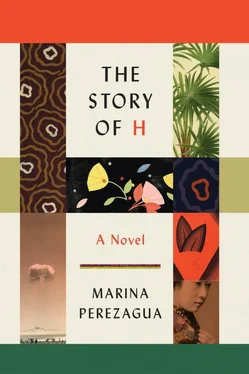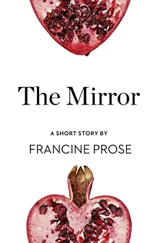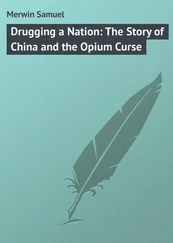The Story of H is an outcry for love and compassion from the center of a profoundly disturbing sensorial world, a barbaric yawp straight from the lungs of a writer for whom imagination and water are inseparable. As a vehicle for metaphors, water is a shifting mirror. It’s the fons et origo that precedes all form. It’s present not only in Marina’s name and in the fluid, incantatory intensity of her prose but also in her free-diving record of lasting five minutes underwater. So saying there’s a breathless quality to this novel is fairly close to a literal description. It’s in the intensity of its conviction, its urgency, its fluid nature, and its constant transformation. While writing The Story of H, Marina trained in the Mediterranean every day and finally swam the Strait of Gibraltar. In four hours.
WATER SYMBOLIZES DEATH and rebirth, purification, eternal return, the ring. In The Story of H, structurally, Marina draws a magic circle, an ouroboros, a serpent biting its own tail. It’s an ancient symbol and archetype, the basic mandala of alchemy. It signifies the assimilation of the opposite, something that is constantly re-creating itself. The construction or creative impulse from destruction, the all in one, is like a school of fish or a conspiracy of ravens. And I write this hoping to persuade readers of the fact that, though Marina’s novel is powerfully creative, oceanic, and visionary in its gallery of images at once horrific and stunningly beautiful, it is not of the magical realist tradition. All that is written in Spanish and is not of a realist bent does not of magical realism come. Marina is first of all an art historian, schooled in the power of ekphrastic expression, how the written description of a visual work of art can become vivid and charged with energy. Time capturing space, describing it vividly, mapping it and bringing it to life, creating polarized opposites that spin and create a frame. She works, as Roberto Bolaño did, in reviving symbolist and surrealist techniques of pictorial imagery in the subtext of her work and in the juxtaposition of magnetic opposites like pain and pleasure or life out of death or salvation amid cruelty and corruption, empathy before a bloodthirsty world driven by violence and kitsch. “Perhaps universal history is the history of a few metaphors,” Borges wrote in the opening of his story “Pascal’s Sphere.” He closed the story with the same sentence, slightly altered: “Perhaps universal history is the history of various intonations of a few metaphors.” In between, he traced a metaphor to give a holistic idea of the universe as atom and globe, primordial form, whose center is everywhere and its circumference nowhere.
* * *
The epicenter of this novel is the sixth of August 1945, when we see the first atomic bomb, Little Boy, plunge from the Enola Gay straight at us there, sitting in class, with H, her schoolmates and teacher, and the hundreds of thousands of civilians in Hiroshima. An angel of death dangling above the city in the form of an American plane. But our H, an intersexual child whose parents choose to see her as a boy even though she identifies as a girl, survives, the only student left alive. “When I came to,” she relates, “the whole school had become a big playground, a playground without monkey bars, a gaping expanse open to a gaping city. […] I watched a naked lump approach me in what had been the bathroom. It asked for water. I was frightened. Its head had swollen to three times the normal size. Only when the lump said her name did I realize it was my teacher. I ran away.”
Through H’s story, Marina individuates History back down to the level of the human, to the pathos, to what it means, the tremor in the collective unconscious at the sudden murder of tens of thousands of people. The heat of the human told with enough imagination to melt the freezing effects of quantification. A poetics of beauty even in horror. Through History and Science, The Story of H pins the narrative to a specific time and place, to reality, like a butterfly to a board. But the imagination is set free—it is revolutionary, boundless. The oneiric world tries to make sense of all that has happened, all that has been broken by violence and war. H confesses to a murder. And the question hovers: does a society that is capable of unleashing an atomic bomb have the moral grounds to judge a woman who has murdered to defend life?
H HAS NO OTHER NAME but this letter. In Spanish, the letter H is silent. In English, this voiceless glottal fricative, as the H sound is called in the parlance of phonetics, can be silent, but it can also be aspirated. These are the felicities of translation, when a detail like this can open a new level of meaning—in this case, the sound captured in a symbol that has been culturally determined over time and historical circumstances. We have hour and honest, which are words from the French and so are silent. There is messiah from the Hebrew, or rhapsody from the Greek, silent by derivation. Or shepherd or exhaust, silent by elision, which in linguistics means merging or shortening a sound. But other words from the French have slowly acquired in English an aspirated H, as in horrible, host, or human . And of course, Hiroshima . Thanks to some strange inner mathematics of sound over time, the aspirated H shows up again in these words. So, readers, our H and her story jump into the English-speaking world and your imaginations outfitted with additional metaphorical possibilities. An aspirated letter for a breathless novel. There’s H, who free-dives with the amas, the Japanese pearl divers whose tradition goes back thousands of years, and nearly succumbs to the narcotic effect of diving into the abyss, and there’s the author, who swims all the way across the Gibraltar while writing H’s story. H wanders the earth like an oni, a Japanese ghost born of destruction and sent into the world to take vengeance, like a gasp of noxious atomic wind sent whirling and churning across the planet, haunting and hunting what was taken from her—the future, the daughter, her love, her penis like a blind lizard stalking her in nightmares. But not her body: “I’ve got life, and nobody can take it away from me.”
H CAN BE SILENT, or H can be an aspiration. The constellation of words in my thesaurus tells me that aspiration is synonymous with desire. Hope. Longing, yearning, urge, wish. It even says fire in the belly and dream. Keep those correspondences in mind when you read the novel. These are the joys of translation: not what’s in a name or even in a word, but what’s in a sound or the lack of it, spinning like a needle in that tiny little letter in the center of a magical circle. You see? You haven’t even started reading yet, and already H is colonizing her space in your imagination.
THE GREAT SPANISH ART HISTORIAN and symbolist poet Juan Eduardo Cirlot, who was close to the surrealists, once wrote about an encounter with a woman in a letter to André Breton: “I am still spellbound by the moonlike pallor of her leg and her semitransparent silk stockings that allowed me to glimpse the features of her flesh and its delicate shadow of very fine down, like the seabed as seen through water, the algae and the urchins. I understood how this gray transparency, like a veil or misted glass, expressed the principle of true mystery, that it’s not a matter of seeing or not seeing, but of glimpsing.”
This novel is about the mystery of sexuality—its fluidity, identity, compulsion—an exploration of the dark, broken places where sexuality manifests itself and its capacity for healing, the body as the center of everything, since without the body, the soul cannot exist. Full of the tension of its juxtaposition of disturbing, sublime images, The Story of H pulls the reader into a maelstrom of passion, pain, and perseverance. Cirlot, in his Dictionary of Symbols, writes in the entry for scars: “The author once dreamed of an unknown damsel ( anima ) whose beautiful face was marked by scars and burns which in no way disfigured her features.” They didn’t take away from her attractiveness and perhaps even increased it. “Moral imperfections, and sufferings (are they one and the same?)[,] are, therefore, symbolized by the wounds and scars caused by fire and sword.” Ah, H.
Читать дальше












